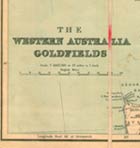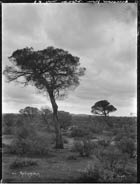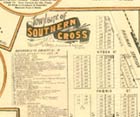Part 3 The Eastern Goldfields

Thirty years after Edmund Ashworth build his cottage at York, Europeans were attracted to the Eastern Goldfields of Western Australia. However, it was not land for farming that attracted them to these semi-arid landscapes. They came for gold. The hope of finding gold or making the most of the opportunities that arose from rapidly expanding new towns lured thousands of men to the Eastern Goldfields. Once towns had been established, married women joined or accompanied their husbands and single women also came seeking work. This final part of 'Finding Home' will discuss the ways in which Charles and Campbell Deland and Maude Wordsworth James, who lived on the Eastern Goldfields in the 1890s and early 1900s, developed a sense of belonging to the area.
 The environment of the goldfields was harsh and alien to the white newcomers who made their way there from Europe, the eastern colonies or from milder areas of the colony of Western Australia. The region is a vast undulating plain with occasional ranges of low hills, there are no permanent rivers, the vegetation is characterised by open eucalypt woodlands, with saltbush and bluebush scrub on the more calcareous soils.[1] The eucalypts, which dominate the vegetation, have adapted to survive in an area where the average rainfall is low and unreliable. The climate is classified as semi-arid to arid with hot summers and mild winters.[2] Extended periods of temperatures in the high thirties are common and occur when dry continental winds persist for many days. They are the winds responsible for the dust that the European people complained about when they came to the Eastern Goldfields in the 1890s, and that was exacerbated when the land was denuded of trees, chopped down to supply fuel to the water condensers, locomotives and mining industry.
The environment of the goldfields was harsh and alien to the white newcomers who made their way there from Europe, the eastern colonies or from milder areas of the colony of Western Australia. The region is a vast undulating plain with occasional ranges of low hills, there are no permanent rivers, the vegetation is characterised by open eucalypt woodlands, with saltbush and bluebush scrub on the more calcareous soils.[1] The eucalypts, which dominate the vegetation, have adapted to survive in an area where the average rainfall is low and unreliable. The climate is classified as semi-arid to arid with hot summers and mild winters.[2] Extended periods of temperatures in the high thirties are common and occur when dry continental winds persist for many days. They are the winds responsible for the dust that the European people complained about when they came to the Eastern Goldfields in the 1890s, and that was exacerbated when the land was denuded of trees, chopped down to supply fuel to the water condensers, locomotives and mining industry.
 The goldrush of the 1890s began west of Kalgoorlie in the Yilgarn district.[3] In 1891 the centre of the most productive goldfields in Western Australia was the town of Southern Cross, 230 kilometres west of Kalgoorlie. When the government announced its intention to extend the railway from Northam to Southern Cross, confidence in the area's gold-producing potential increased. Prospectors were enticed to the district and continued to push further east in their quest for gold. Two of these prospectors were Arthur Bayley and William Ford who, in 1892, found gold at Coolgardie.[4] Almost overnight Southern Cross was deserted as hundreds of men made their way to Coolgardie by cart, horseback or on foot. A year later later Patrick Hannan, Tim Flanagan and Daniel Shea found gold at Kalgoorlie and Samuel Brockman and William Pearce staked their claim at Boulder. The rush was on. As Kalgoorlie was established, more men, women and their families joined the prospectors to set up businesses, or to find work in a variety of positions demanded by the rapidly expanding town.
The goldrush of the 1890s began west of Kalgoorlie in the Yilgarn district.[3] In 1891 the centre of the most productive goldfields in Western Australia was the town of Southern Cross, 230 kilometres west of Kalgoorlie. When the government announced its intention to extend the railway from Northam to Southern Cross, confidence in the area's gold-producing potential increased. Prospectors were enticed to the district and continued to push further east in their quest for gold. Two of these prospectors were Arthur Bayley and William Ford who, in 1892, found gold at Coolgardie.[4] Almost overnight Southern Cross was deserted as hundreds of men made their way to Coolgardie by cart, horseback or on foot. A year later later Patrick Hannan, Tim Flanagan and Daniel Shea found gold at Kalgoorlie and Samuel Brockman and William Pearce staked their claim at Boulder. The rush was on. As Kalgoorlie was established, more men, women and their families joined the prospectors to set up businesses, or to find work in a variety of positions demanded by the rapidly expanding town.
With a population of 9,617 in 1891,[5] Perth was small compared with the capitals of the eastern colonies during the 1890s, but there were, at least, substantial buildings, roads, pavements, banks, houses and public gardens. On the Eastern Goldfields, however, European settlements were just becoming established. The most common form of housing was 'tents': temporary constructions of canvas with wooden frames and floors of sand or canvas. Furniture was basic and usually made from packing cases and old kerosene tins. Wealthier people such as mine managers lived in brick houses with corrugated iron roofs and were able to bring special items of furniture from their previous houses.[6] Fresh water was scarce, very expensive to buy and with the heat, the dust and the prevalence of typhoid, life was tough for many newcomers, unused to such conditions. Indeed, Charles and Campbell Deland and Maude Wordsworth James commented on these trying living conditions. Did they, though, come to feel 'at home' in this place?
Page last updated: Thursday 23 February 2012 by Illona Tobin Asset ID 44560
Editors for this page nick 2nd account
login




